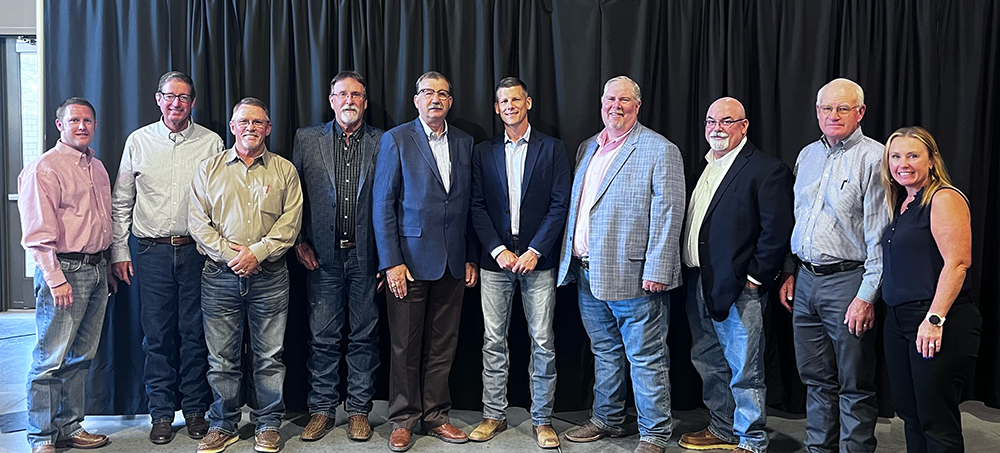Welcome to the August 18, 2023 issue of Cotton News, a service provided by Plains Cotton Growers Inc. for the cotton industry in the Texas High Plains and beyond.

Fight for the Farm Bill
The August recess has allowed opportunities for producers and the cotton industry to discuss priorities and challenges with their elected officials.
On August 16, a Farm Bill listening session, hosted by West Texas A&M University, was held in Canyon, Texas, where many cotton industry representatives gathered to provide Reps. Ronny Jackson and Jodey Arrington with their priorities for strong farm policy regarding the 2023 Farm Bill.
PCG President Martin Stoerner, presented PCG’s priorities for the Farm Bill emphasizing the need to increase reference prices to reflect cost of production and to enhance crop insurance to further mitigate risk and alleviate the need for future ad hoc disaster assistance. Additionally, PCG supports abolishing the prohibition of a producer’s ability to participate in the Stacked Income Protection Program (STAX) and the Price Loss Coverage program (PLC).
“Due to the elevated input costs we are now experiencing, the reference price is no longer as effective as when it was initially set,” Stoerner added. 
Curtis Stewart, manager of Spade Cooperative Gin, Inc. communicated the need for infrastructure support.
“Long-term assistance for infrastructure in the form of affordable insurance or intermittent disaster assistance for cotton gins, warehouse, merchants and other downstream industry is needed to help weather the woes of Mother Nature, which is outside our control.”
Rep. Ronny Jackson, who serves on the House Agriculture Committee, joined Arrington the next day in Lubbock for a Farm Bill Roundtable. Complementary to Martin Stoerner’s testimony at the Farm Bill listening session, producer and President of RPCG Sutton Page of Avoca, Texas joined PCG at the Lubbock roundtable and reemphasized cotton’s main priorities for the next Farm Bill. In response to the current prohibition of combining STAX insurance with PLC, Jackson said, “I have five top priorities that I’m pushing for in the Farm Bill this year. And the possibility to combine STAX with PLC is one of them.”
Brady Raindl, director of USA Purchasing for ECOM USA and American Cotton Shippers Association (ASCA) director, emphasized the merchant/farmer partnership and encouraged both congressmen to remember the hardships of growing a cotton crop in West Texas.
“As a merchandiser, farmers aren’t just customers to me,” Raindl said. “They’re my partner. ASCA supports an expanded safety net for producers, increasing the current reference price, and focusing on stronger risk management tools like crop insurance and measures to ensure healthy and financially robust markets. And as we consider increasing the safety net, we believe that it’s important to modernize the Marketing Assistance Loan Program to ensure that cotton can move into the marketplace in an orderly fashion without incurring unnecessary cost to stakeholders or government support programs.”
In his closing remarks, Arrington emphasized the need for program integrity across the board, including farm programs. And both Arrington and Jackson highlighted the fight that will happen for upcoming farm policy and how both are willing to ‘go to bat’ for an effective Farm Bill.
Plains Ginners Association Annual Meeting
The Plains Ginners Association annual meeting is scheduled for August 21 at the FiberMax Center for Discovery starting at 8 am.
The speaker lineup consists of Steve Friskup, owner/auctioneer of Clovis Horse Sales, Clint Kriehbel, Ph.D., TTU Davis College Dean; Darren Hudson, Ph.D., will provide an economic report; and Gary Adams, NCC President and CEO will provide a Washington D.C. update.
Lunch will be provided at the conclusion of the meeting and a golf tournament that afternoon. Sign up for the golf tournament here.
Questions? Call the office: 806-792-4904.
Current Pest and Crop Conditions
By Kerry Siders, IPM Agent for Cochran, Lamb and Hockley Counties
Cotton ranges from just starting to bloom to hard cut-out (0 nodes above white flower). Ideally, cotton will be blooming out-the-top by now, because we have reached that point when the odds of a bloom developing into a quality/yield contributing harvestable boll will drop considerably over the next few days. In fact, producers have probably noticed fields beginning to shed squares and some small bolls this week. This is a normal process of the plant making a final adjustment in what the plant can naturally hold and mature out. Though, producers should make sure that this fruit shed is natural and not induced by some insect like worms or Lygus. I have seen a few bollworm eggs around, but, between heat and beneficial insects and spiders, I am not finding any larva. I can still find a few cotton aphids as well and whiteflies. Most of these aphids are few and far between mostly due to the same beneficials working on the worms.
I would encourage producers to continue scouting for a few more weeks. By September 1 most cotton acres should have well over 400 heat units accumulated since reaching more than five nodes above white flower stage (August 5). This gauge of time tells us that a crop is safe from most insect damage.
Here of late, questions about irrigation have been more prominent. I will admit I get conservative with irrigation as we move into the last days of August and would rather err on the side of being too dry than too wet going into September. However, as hot and dry as we have been for the last four to six weeks, I am encouraging most to stay with the irrigation as long as is feasible. We have already had our chance of making quantity, now it is a matter of achieving quality through maturity. The last bolls set during this time need to be relatively stress free for 20 days (approximately September 8). So, if the plant recovers quickly from any wilting during a 90+ degree day then those last bolls formed should mature properly. Forty to 45 days after the last harvestable boll is formed (approximately September 30), the plant can nearly go into permanent wilt without impacting yield or quality.
So, bottom line, I am encouraging producers to stay with the water for another 10 to 14 days at least.